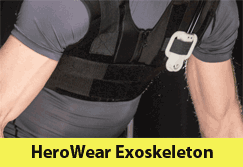So called wearable devices to improve safety for distribution centers were much in the news this week.
That included a story in the Wall Street Journal discussing a system from New York-based startup named StrongArm Technologies, a firm with an interesting wearable system SCDigest has reported on before (see Walmart, Other Companies Testing New Safety Monitoring Device for DC Workers).
Supply Chain Digest Says...
|
 |
Even somewhat lesser versions of Tony Stark's Iron Man suits may soon find their way into DCs. |
 |
What do you say? |
| Click here to send us your comments |
 |
| Click here to see reader feedback |
|
While still in the very early stages of adoption, a number of companies are testing StrongArm's solution, which uses a series of sensors that can identify when DC workers are doing risky movements, such as lifting something using their backs instead of primarily their legs, and signal them to change that form in real time.
Another New York company called Kinetic uses a slightly approach to track body mechanics of workers for the same basic purpose.
The Journal notes the StrongArm system also collects data that employers can use to assess how new equipment, tasks or changes in production volume affect worker safety.
The goal is obviously to reduce worker injuries – and with it time off and sometimes worker's compensation claims.
One of the companies testing the StrongArm technology is an Australian wholesaler named Metcash, which is running a six-month pilot of the system.
The Journal says about 100 workers at one DC are wearing StrongArm's devices on their chests using a harness type holder as they pick cases of beer or hardware items on to pallets.
If the right ergonomics are not followed by a worker, sensors vibrate to remind workers to keep their backs straight or not twist too quickly. In addition to signaling workers in real-time, companies can also use the data overtime to assess riskier tasks and workers, and provide training to employees as needed.
"It's not about productivity or pick rates or any of that," Ed Napiorkowski, a Metcash manager, told the Journal, adding that. "It's about reducing the chance of people getting hurt."
Walmart is also running a pilot of the StrongArm system at eight of its distribution centers.
There are certainly concerns in some quarters that the StrongArm technology will somehow be used in "big brother" fashion in terms of monitoring workers – and that the data will somehow be used to punish employees.
But Jack Dennerlein of Northeastern University in Boston, who studies workplace ergonomics, says that type of program will be unlikely to succeed.
(See More Below)
|
CATEGORY SPONSOR: SOFTEON |
|
|
| |
|
|
"This idea of it being a monitor of how workers are behaving, using a carrot and stick, that's not going to work," Dennerlein says.
Meanwhile, document-storage company Iron Mountain began using the Kinetic system three years ago to reduce unsafe postures that can lead to sprains and strains among DC workers. Kinetic's technology takes the motion of the wearer's hip and uses artificial intelligence and algorithms to reconstruct what that person's body must have done to make it move that way, then determines whether the motion is unsafe.
Iron Mountain it has experienced a on average across facilities a 45% reduction in at-risk postures that could lead to injuries during the test, and that it is expandingT he program to more than 60 sites in 2020.
 Also this week, at MHI's coronavirus challenged MODEX trade show in Atlanta, the Tueday morning keynote speaker was Olivier Oullier, president of EMOTIV, a firm that says on its web site that it enabled companies to "analyze, and experiment with brain data through our portable and accessible brain measuring solutions." Also this week, at MHI's coronavirus challenged MODEX trade show in Atlanta, the Tueday morning keynote speaker was Olivier Oullier, president of EMOTIV, a firm that says on its web site that it enabled companies to "analyze, and experiment with brain data through our portable and accessible brain measuring solutions."
What does that have to do with warehouse workers?
EMOTIV uses something called electroencephalography (EEG) wearables, in the form of various headsets – some as small as ear buds – to measure that brain activity.
From there, Oullier said, the devices can not only sense and understand brain activity to adjust workplace processes or the track the actions of individual workers, they can also serve as a "mind/machine" interface to actually control machines.
There is a safety play was well, as the devices can apparently track the stress levels of workers – or tie what is going on in the brains of workers at the time of accidents or other health and safety issues, using that data to remediate those risks.
And even somewhat lesser versions of Tony Stark's Iron Man suits may soon find their way into DCs.
For example, a company called HeroWear makes a form of "exoskeleton" that uses elastic bands that run across the back and connect to the shoulders and thighs to carry some of the load for lifting activities.
The elastic band stretches as worker leans down, which reduces the load because the elastic has stored up energy in the band, it makes it easier to pop back up.
And as we have reported before, Amazon has received a few patents for varius forms of new wearable devices, mostly tied to productivity not safety, but SCDigest does not believe any of them have been actally deployed in Amazon DCs.
Are you for or against these new age wearable devices? Let us know your thoughts at the Feedback section below.
|